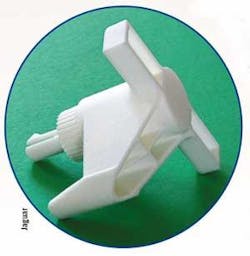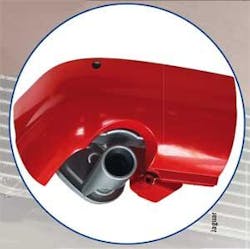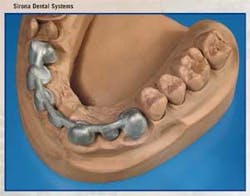New materials and techniques enable laser sintering to enter new markets with automotive and medical applications
Stuart Jackson
The techniques and materials used in rapid prototyping (RP) are developing as fast as the new products it helps design. From epoxy resin to biocompatible cobalt chrome alloy, the materials that can be used and the speed, customization, and precision of laser sintering has exploded the traditional boundaries of prototyping in traditional and new markets.
Frequently referred to as additive layer manufacturing (ALM), laser sintering adds flexibility to both product development and manufacturing by allowing the creation of geometries that, until now, were impossible or prohibitively expensive to build. Early adopters of ALM technology can be found in many industries, including aerospace, automotive, medical, and dental; sporting and recreational goods manufacture; and a wide range of plastic and metal service suppliers.
The main reasons for adopting laser sintering include the need to customize products, create complex geometries, reduce production lead times, and manufacture in production volumes too low to be cost effective using traditional processes.
Jaguar Cars
Jaguar Cars is increasingly using the latest technologies at its Whitley Engineering Centre to speed the development of new vehicles by making plastic parts directly from CAD models, eliminating the expense of producing mould tools.
A leading role is being played by laser sintering machines that create prototype trim and even engine parts from nylon powder (polyamide PA2200) by fusing them layer by layer into their respective shapes.
The resulting components, such as the air intake manifold, door inners, fascia substrate, interior air vents, and exterior light housings, are robust enough to be used on test vehicles running around the track, allowing more data to be collected early on in the development process. By contrast, other rapid prototyping techniques that employ such materials as epoxy resin and ABS produce relatively fragile parts that are best suited to visualization.
Take the V8 air intake manifold prototype for a recently introduced Jaguar car, for example. In the past, hundreds of thousands of pounds/dollars would have been invested in hard tooling for its manufacture. Following every design change, it would have cost thousands of pounds/dollars to alter the tool, a process which would have taken several weeks each time. If the changes were substantial, a completely new tool might be needed.
Using laser sintering RP technology, two design iterations of the manifold were produced and 17 were then built in nylon for <£1000 each and in a lead time of 1.5 days per manifold. It represented an enormous financial saving in the development of this vehicle component alone and has halved the time needed to perfect it from one year to six months.
Whitley’s RP department
The RP department at the Whitley Centre is run as a profit center within the Premier Automotive Group (PAG). It regularly receives work in the form of STL files from a number of sources within the group, primarily the design, aerodynamics, body, chassis, electrical, power train, and engineering departments within Jaguar and Land Rover.
The engineering center started using RP in 1997 to build parts in layers using STL files extracted from CAD models. Among the components produced were small models of complete vehicle exteriors for visualization and detailed scale models of structural parts for wind tunnel tests.
By 2000, however, it became clear that a further RP technique was desirable–one that allowed robust parts to be produced that would withstand the rigors of functional testing. This is where laser sintering comes into its own. The company installed two EOSINT P360s, later upgraded to P380 performance by the addition of new software and hardware that give an even better component finish and up to 30% faster build times.
One of the first jobs run on the machines was a door assembly model for the XJ saloon. It was used as a robust development aid around which the shape of the protective security shield for the car door could be developed in advance of production parts. The model stood up well to the task, whereas a similar part produced using stereolithography, for example, would have been too brittle.
A larger, laser sintered component for the same vehicle followed, namely a bumper section built in two pieces that was used for visualizing the assembly of key parts such as the exhaust pipe and tow eye fixing. The aesthetics of this part of the vehicle could therefore be evaluated before progressing to hard tooling.
The EOSINT P380s operate 24/7 at the Whitley Product Development Centre, producing within its 340 x 340 x 620mm build envelope a myriad of PAG parts, for which the STL files are managed in a database with scheduling capability. Parts are positioned using Magics software from Materialise for optimum use of the build volume.
Jaguar’s experience has been that the throughput of laser sintered parts exceeds that of other RP processes, as the entire build volume can be filled with parts whereas with the other processes it operates, parts may be fitted within the area of the build platform only.
The nesting flexibility of the EOSINT P380s makes it easy to incorporate dozens of parts in each sintering cycle. As the technology provides one-offs or batches of parts quickly, efficiently, and cost effectively, tools, mould inserts, and functional parts can also be manufactured.
An interesting component that is regularly added around other parts is not a prototype at all, but a complex plastic assembly aid that assists operators working on the XK coupé and convertible to position the window lift mechanisms during build.
A stock of 3000 of these parts was required by the manufacturing plant, as, once fitted, the assembly aid remains on the vehicle throughout the build process. All the parts were produced on the P380s as fill-in jobs, without the need to invest in expensive plastic injection mould tooling.
As to the future, Jaguar expects to see rapid prototyping quickly develop into rapid manufacturing processes, initially capable of satisfying niche requirements. In the more distant future, it is possible that today’s RP processes hold the key to the next generation of volume production technologies where the design constraints, tooling, and inventory overheads of today’s processes might be eliminated.
Following the success of the XK window tool project, it is certain that Jaguar will continue to produce plastic components for prototype and niche applications such as the window lift assembly aid.
From automotive to medical
The opportunities created by rapid manufacturing processes have also been spotted in the medical market. For example, one dental service group approached EOS with a goal of laser sintering two batches of 200 individually customized copings and bridges a day. The company reports that it was able to meet and exceed those requirements. The new way of manufacturing bespoke dental prostheses is an order of magnitude more efficient than conventional techniques.
Sirona Dental Systems
The technique was developed by a German company, Sirona Dental Systems–in collaboration with EOS–that supplied the direct metal laser sintering (DMLS) machines and the consumable metal powders used in them, including a bio-compatible cobalt chrome alloy developed especially for the application.
With around 12 million dental prostheses required each year in Germany alone, production is likely to increase considerably over the coming years. The process begins with an impression of the patient’s teeth being sent from the dental surgeon to Sirona’s laboratory, where a plaster model is produced. A non-contact scanner creates a digital model of the teeth and the required framework is designed using CAD/CAM software.
Construction data is sent over the internet to Sirona, where the files are used to drive the laser in a DMLS machine to fuse successive, ultra-thin layers of cobalt-chrome powder until exact physical representations of the required prosthesis frameworks are created.
Laborious manual modeling and casting in the laboratory are no longer needed, dramatically improving efficiency. Whereas a dental technician can typically process about ten crowns per working day, several hundred frameworks can be built in the same time in the DMLS machine. Turnaround times for orders are three working days from receipt of the construction data.
“Industrial production of dental frameworks by DMLS is not only more cost effective, but also provides consistently high quality,” commented Dr. Saliger, project manager at Sirona’s infiniDent division.
This application shows the suitability of the technology for the manufacture of individual products in the medical environment. Laser sintering technology also has a high potential for the production of patient-specific implants.
Laser sintering will be available in a broader range of materials including flexible and ductile plastics and new, colored plastics for use across all industry sectors. EOS predicts the growth rate in the market will be extraordinary in the coming years.
Stuart Jackson ([email protected]) is the regional manager of EOS Electro Optical Systems Ltd. (www.eos.info), Warwick, UK; ph 44/1926-623107.



